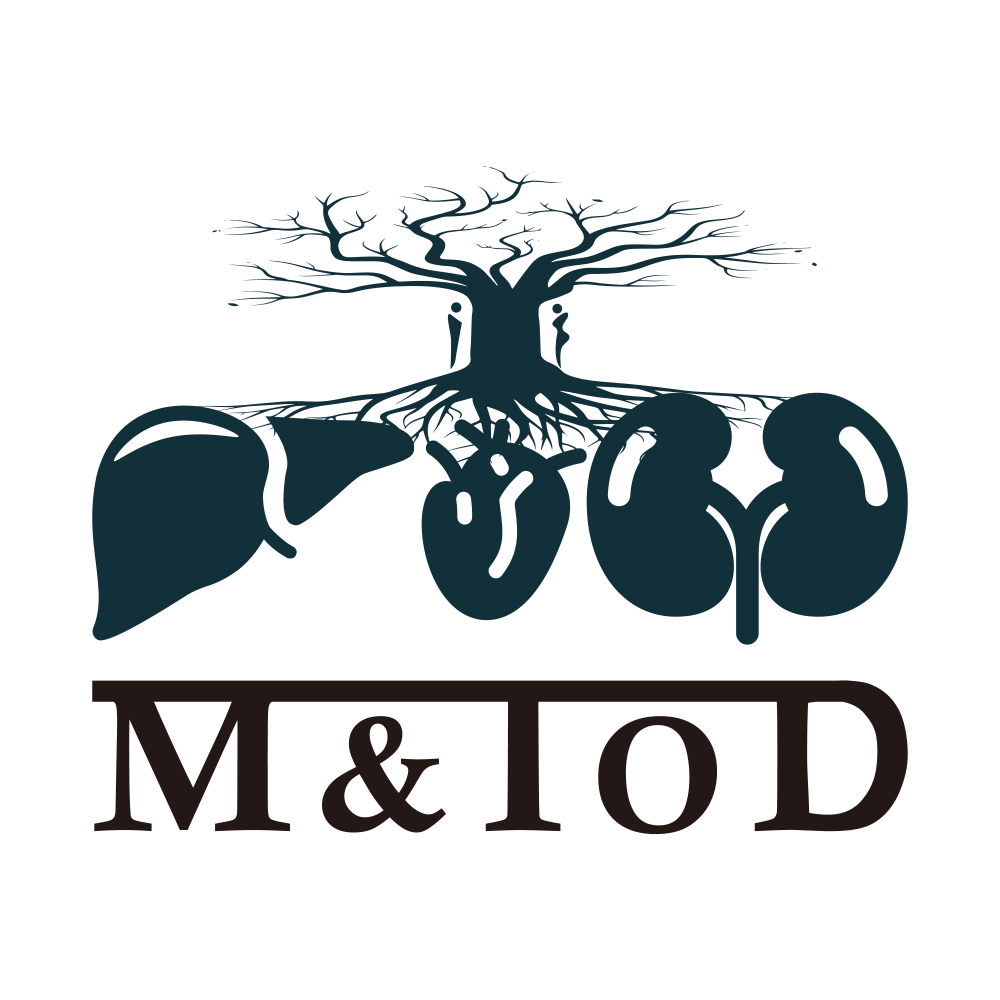REFERENCES
1. Wentworth BJ. Metabolic dysfunction-associated steatotic liver disease throughout the liver transplant cycle: a comprehensive review. Metab Target Organ Damage. 2025;5:2.
2. Zheng Q, Rui L. Epigenetic and epitranscriptomic regulations of metabolic dysfunction-associated steatotic liver disease. Metab Target Organ Damage. 2024;4:43.
3. Targher G, Byrne CD, Tilg H. MASLD: a systemic metabolic disorder with cardiovascular and malignant complications. Gut. 2024;73:691-702.
4. Stefan N, Yki-Järvinen H, Neuschwander-Tetri BA. Metabolic dysfunction-associated steatotic liver disease: heterogeneous pathomechanisms and effectiveness of metabolism-based treatment. Lancet Diabetes Endocrinol. 2025;13:134-48.
5. Ajayi T, Moon G, Chen S, Pan S, Oseini A, Houchen C. Surging liver transplantation for nonalcoholic steatohepatitis from 2000-2022: a national database study. South Med J. 2024;117:302-10.
6. Noureddin M, Vipani A, Bresee C, et al. NASH leading cause of liver transplant in women: updated analysis of indications for liver transplant and ethnic and gender variances. Am J Gastroenterol. 2018;113:1649-59.
7. Younossi ZM, Stepanova M, Ong J, et al. Nonalcoholic steatohepatitis is the most rapidly increasing indication for liver transplantation in the United States. Clin Gastroenterol Hepatol. 2021;19:580-9.e5.
8. Hu Y, Geng Q, Wang L, et al. Research progress and application of liver organoids for disease modeling and regenerative therapy. J Mol Med. 2024;102:859-74.
9. Yuan X, Wu J, Sun Z, et al. Preclinical efficacy and safety of encapsulated proliferating human hepatocyte organoids in treating liver failure. Cell Stem Cell. 2024;31:484-98.e5.
10. Zhang W, Cui Y, Du Y, et al. Liver cell therapies: cellular sources and grafting strategies. Front Med. 2023;17:432-57.
11. Lotto J, Stephan TL, Hoodless PA. Fetal liver development and implications for liver disease pathogenesis. Nat Rev Gastroenterol Hepatol. 2023;20:561-81.
12. Nevzorova YA, Boyer-Diaz Z, Cubero FJ, Gracia-Sancho J. Animal models for liver disease - a practical approach for translational research. J Hepatol. 2020;73:423-40.
13. Farrell G, Schattenberg JM, Leclercq I, et al. Mouse models of nonalcoholic steatohepatitis: toward optimization of their relevance to human nonalcoholic steatohepatitis. Hepatology. 2019;69:2241-57.
15. Shirini K, Ladowski JM, Meier RPH. Xenotransplantation literature update July-December 2024. Xenotransplantation. 2025;32:e70027.
16. Segovia-Miranda F, Morales-Navarrete H, Kücken M, et al. Three-dimensional spatially resolved geometrical and functional models of human liver tissue reveal new aspects of NAFLD progression. Nat Med. 2019;25:1885-93.
18. Marsee A, Roos FJM, Verstegen MMA, et al; HPB Organoid Consortium. Building consensus on definition and nomenclature of hepatic, pancreatic, and biliary organoids. Cell Stem Cell. 2021;28:816-32.
19. Tang XY, Wu S, Wang D, et al. Human organoids in basic research and clinical applications. Signal Transduct Target Ther. 2022;7:168.
20. Cao W, Li M, Liu J, et al. LGR5 marks targetable tumor-initiating cells in mouse liver cancer. Nat Commun. 2020;11:1961.
21. Cao W, Chen K, Bolkestein M, et al. Dynamics of proliferative and quiescent stem cells in liver homeostasis and injury. Gastroenterology. 2017;153:1133-47.
22. Lin Y, Fang ZP, Liu HJ, et al. HGF/R-spondin1 rescues liver dysfunction through the induction of Lgr5+ liver stem cells. Nat Commun. 2017;8:1175.
23. Huch M, Dorrell C, Boj SF, et al. In vitro expansion of single Lgr5+ liver stem cells induced by Wnt-driven regeneration. Nature. 2013;494:247-50.
24. Prior N, Hindley CJ, Rost F, et al. Lgr5+ stem and progenitor cells reside at the apex of a heterogeneous embryonic hepatoblast pool. Development. 2019;146:dev174557.
25. Schneeberger K, Sánchez-Romero N, Ye S, et al. Large-scale production of LGR5-positive bipotential human liver stem cells. Hepatology. 2020;72:257-70.
26. Tonooka Y, Takaku T, Toyoshima M, Takahashi Y, Kitamoto S. Suppression of the epithelial-mesenchymal transition and maintenance of the liver functions in primary hepatocytes through dispersion culture within a dome-shaped collagen matrix. Biol Pharm Bull. 2024;47:1241-7.
27. He Y, Gao M, Zhu X, et al. Large-scale formation and long-term culture of hepatocyte organoids from streamlined in vivo genome-edited GGTA1-/- pigs for bioartificial liver applications. Xenotransplantation. 2024;31:e12878.
28. Luo M, Lai J, Zhang E, et al. Rapid self-assembly mini-livers protect mice against severe hepatectomy-induced liver failure. Adv Sci. 2024;11:e2309166.
29. Mathapati S, Siller R, Impellizzeri AA, et al. Small-molecule-directed hepatocyte-like cell differentiation of human pluripotent stem cells. Curr Protoc Stem Cell Biol. 2016;38:1G.6.1-18.
30. Septiana WL, Noviantari A, Antarianto RD. Induced pluripotent stem cells (Ipscs) based liver organoid: the benefits and challenges. Cell Physiol Biochem. 2023;57:345-59.
31. Hidalgo-Álvarez J, Salas-Lucia F, Vera Cruz D, Fonseca TL, Bianco AC. Localized T3 production modifies the transcriptome and promotes the hepatocyte-like lineage in iPSC-derived hepatic organoids. JCI Insight. 2023;8:e173780.
32. Reza HA, Farooqui Z, Reza AA, et al. Synthetic augmentation of bilirubin metabolism in human pluripotent stem cell-derived liver organoids. Stem Cell Reports. 2023;18:2071-83.
33. Septiana WL, Ayudyasari W, Gunardi H, et al. Liver organoids cocultured on decellularized native liver scaffolds as a bridging therapy improves survival from liver failure in rabbits. In Vitro Cell Dev Biol Anim. 2023;59:747-63.
34. Tsuzuki S, Yamaguchi T, Okumura T, Kasai T, Ueno Y, Taniguchi H. PDGF receptors and signaling are required for 3D-structure formation and differentiation of human iPSC-derived hepatic spheroids. Int J Mol Sci. 2023;24:7075.
35. McCarron S, Bathon B, Conlon DM, et al. Functional characterization of organoids derived from irreversibly damaged liver of patients with NASH. Hepatology. 2021;74:1825-44.
36. Salas-Silva S, Kim Y, Kim TH, et al. Human chemically-derived hepatic progenitors (hCdHs) as a source of liver organoid generation: application in regenerative medicine, disease modeling, and toxicology testing. Biomaterials. 2023;303:122360.
37. Hess A, Gentile SD, Saad AB, et al. Author correction: single-cell transcriptomics stratifies organoid models of metabolic dysfunction-associated steatotic liver disease. EMBO J. 2024;43:6792-5.
38. Ietto G, Iori V, Gritti M, et al. Multicellular liver organoids: generation and importance of diverse specialized cellular components. Cells. 2023;12:1429.
39. Jo S, Park SB, Kim H, et al. hiPSC-derived macrophages improve drug sensitivity and selectivity in a macrophage-incorporating organoid culture model. Biofabrication. 2024;16:035021.
40. Li Y, Nie Y, Yang X, et al. Integration of Kupffer cells into human iPSC-derived liver organoids for modeling liver dysfunction in sepsis. Cell Rep. 2024;43:113918.
41. Li H, Li J, Wang T, et al. Hepatobiliary organoids differentiated from hiPSCs relieve cholestasis-induced liver fibrosis in nonhuman primates. Int J Biol Sci. 2024;20:1160-79.
42. Wu F, Wu D, Ren Y, et al. Generation of hepatobiliary organoids from human induced pluripotent stem cells. J Hepatol. 2019;70:1145-58.
43. Davoodi P, Rezaei N, Hassan M, Hay DC, Vosough M. Bioengineering vascularized liver tissue for biomedical research and application. Scand J Gastroenterol. 2024;59:623-9.
44. Stefan N, Schick F, Birkenfeld AL, Häring HU, White MF. The role of hepatokines in NAFLD. Cell Metab. 2023;35:236-52.
45. Correia de Sousa M, Delangre E, Berthou F, et al. Hepatic miR-149-5p upregulation fosters steatosis, inflammation and fibrosis development in mice and in human liver organoids. JHEP Rep. 2024;6:101126.
46. Kimura M, Iguchi T, Iwasawa K, et al. En masse organoid phenotyping informs metabolic-associated genetic susceptibility to NASH. Cell. 2022;185:4216-32.e16.
47. Gwag T, Lee S, Li Z, et al. Platelet-derived thrombospondin 1 promotes immune cell liver infiltration and exacerbates diet-induced steatohepatitis. JHEP Rep. 2024;6:101019.
48. Lee J, Gil D, Park H, et al. A multicellular liver organoid model for investigating hepatitis C virus infection and nonalcoholic fatty liver disease progression. Hepatology. 2024;80:186-201.
49. Qi L, Matsuo K, Pereira A, et al. Human iPSC-derived proinflammatory macrophages cause insulin resistance in an isogenic white adipose tissue microphysiological system. Small. 2023;19:e2203725.
50. Qi L, Groeger M, Sharma A, et al. Adipocyte inflammation is the primary driver of hepatic insulin resistance in a human iPSC-based microphysiological system. Nat Commun. 2024;15:7991.
51. Cherubini A, Ostadreza M, Jamialahmadi O, et al; EPIDEMIC Study Investigators. Interaction between estrogen receptor-α and PNPLA3 p.I148M variant drives fatty liver disease susceptibility in women. Nat Med. 2023;29:2643-55.
52. Hendriks D, Brouwers JF, Hamer K, et al. Engineered human hepatocyte organoids enable CRISPR-based target discovery and drug screening for steatosis. Nat Biotechnol. 2023;41:1567-81.
53. Cheng W, Zhou Y, Xie Y, et al. Combined effect of polystyrene microplastics and bisphenol A on the human embryonic stem cells-derived liver organoids: the hepatotoxicity and lipid accumulation. Sci Total Environ. 2023;854:158585.
54. McCarron S, Bathon B, Conlon DM, et al. Functional characterization of organoids derived from irreversibly damaged liver of patients with NASH. Hepatology. 2021;74:1825-44.
55. Yildiz E, El Alam G, Perino A, et al. Hepatic lipid overload triggers biliary epithelial cell activation via E2Fs. Elife. 2023;12:e81926.
56. Wang L, Li M, Yu B, et al. Recapitulating lipid accumulation and related metabolic dysregulation in human liver-derived organoids. J Mol Med. 2022;100:471-84.
57. Chen J, Zhou Y, Liu Z, et al. Hepatic glycogenesis antagonizes lipogenesis by blocking S1P via UDPG. Science. 2024;383:eadi3332.
58. Kømurcu KS, Wilhelmsen I, Thorne JL, et al. Mass spectrometry reveals that oxysterols are secreted from non-alcoholic fatty liver disease induced organoids. J Steroid Biochem Mol Biol. 2023;232:106355.
59. Elbadawy M, Tanabe K, Yamamoto H, et al. Evaluation of the efficacy of mitochondrial fission inhibitor (Mdivi-1) using non-alcoholic steatohepatitis (NASH) liver organoids. Front Pharmacol. 2023;14:1243258.









